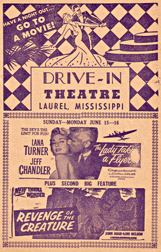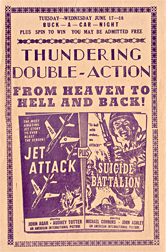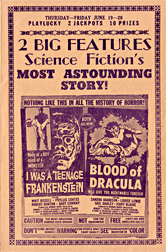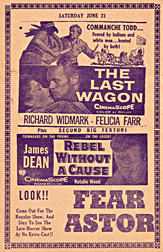Here are 10 things you should know about Margaret Wycherly, born 144 years ago (or thereabouts) today. Though she focused primarily on her stage career, she left an enduring screen legacy.
Tag: White Heat
Cagney Under the Stars!
Imagine you’re at the drive-in, watching a war picture, and James Cagney pulls up in the space next to you.
That’s what happens in this memorable scene from White Heat (1949). Cody Jarrett (Cagney), on the lam with Ma Jarrett (Margaret Wycherly) and his wife, Verna (Virginia Mayo), after shooting a police detective, eludes the cop in hot pursuit by making a quick right turn into the San-Val drive-in as the police siren recedes into the distance.
The theatre’s marquee touts a double feature of South of St. Louis (1949) and Siren of Atlantis (1949), but the movie actually seen on the screen as Cody and Co. settle in to discuss their plans is Task Force (1949), starring Gary Cooper and Jane Wyatt.
We enjoyed seeing the uniformed attendants offering peanuts and popcorn and placing the speaker just so in the passenger-side window. We couldn’t help but wonder just how many such attendants the San-Val employed on a busy Saturday night back in 1949 (if, in fact, it employed any attendants; it’s possible that was a creative touch added by the producers of the picture)
Burbank’s San-Val, the second drive-in ever built in California, opened in 1938 (the first, called The Drive-in Theatre, opened for business in 1934 at 10850 W. Pico Boulevard in Los Angeles) and was shuttered in the mid-1970s. The theatre, which originally had a capacity of 590 cars (it later accommodated more than 800 cars), was located at 2720 Winona Avenue, at the confluence of Winona, Naomi Street and San Fernando Road. An office building housing a number of movie production and effect houses now occupies the spot.
Past Paper, pt. 5: At the Drive-in, ca. 1958
Drive-in movies theatres are connected in the minds of many with the 1950s and ’60s, and those decades might certainly be fairly considered the heyday of the “ozoner,” which is the term Variety has used for drive-ins for many years.
But as drive-in buffs and regular readers of Cladrite Radio well know, the first drive-in opened way back in 1933, and by the 1940s, outdoor theatres had cropped up all over the country.
You can even catch scenes in drive-ins in some movies of the 1940s (we know of no such scenes in the 1930s, though we’d love to be corrected if some exist). Perhaps most memorable is the scene in White Heat (1949), when Cody Jarrett, so memorably portrayed by James Cagney, pulls into Burbank, California’s San-Val Drive-in as he tries to elude capture by a pursuing police car with sirens at full volume.
(The San-Val, by the way, was the second drive-in ever built in California. It opened for business in 1938 and was shuttered in the mid-1970s.)
There are many today who believe the drive-in to be all but extinct, but that’s simply not the case. There are far fewer today than there once were, it’s true, but there are still between 400-450 ozoners in operation, and many of those are thriving.
There are dearly held clichés about the drive-in experience that have been around since the 1950s and may never die, chief among them being the idea that the drive-in is a place where teenagers congregate to get away from their parents and misbehave in various and sundry ways, that the average drive-in is more a passion pit than a movie theatre.
But today’s drive-ins are relying more on family fare than the exploitation pictures and troubled teen epics of yesteryear. And in doing so, they are actually returning to their roots, for the drive-in wasn’t always a place for restless youth to meet and mingle.
One of the strongest selling points for early drive-ins was that they eliminated the need for a baby-sitter. Parents could dress the kids in their PJs and enjoy a night at the movies, with Junior and Sis nodding off in the back seat long before the second feature started.
Drive-ins also sold the idea that you could “come as you are.” Folks still dressed up a bit to go to the movies in the 1940s and ’50s—at least, if they were attending a downtown movie palace, they did—but they could patronize their local ozoner in their shirt sleeves.
We love finding advertising flyers for drive-ins, like the one pictured below.
 Hi-res view |
 Hi-res view |
 Hi-res view |
 Hi-res view |
We’re not entirely certain which drive-in this flyer is from, as Laurel, Mississippi, appears to have played host to four different ozoners over the years—the Crossley, the Northside Twin, the Original, and the Rebel Drive-In—and we’re not entirely certain whether all were in operation in 1958, when this flyer was printed.
But the flyer does shine an interesting light on the unnamed theatre’s booking policies.
There are eight pictures listed on the flyer—four double features—and only four of those eight pictures—I Was a Teenage Frankenstein, The Lady Takes a Flyer, Jet Attack, and Suicide Battalion—came out in 1958. Revenge of the Creature and Rebel without a Cause were released three years earlier, in 1955; The Last Wagon came out in 1956; and Blood of Dracula was a 1957 release.
It’s as if you went to see, say, Toy Story 3 at your local drive-in, and it was paired as part of a double-bill with The Simpsons Movie or Superbad.
On the other hand, the four older movies are available today on DVD, while the same is true of none of the 1958 releases. What that says about the quality of movies released in the year we were born (and possibly about us, too), we’ll leave to you to decide.
